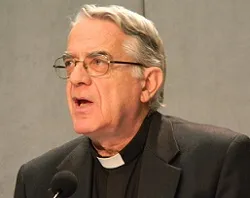Fr. Federico Lombardi met with the press on Oct. 29 to present the schedule for the Pope's Nov. 6-7 visit to Spain.
The trip is divided between two major Spanish destinations, the Cathedral of Santiago de Compostela in the Northwest region of Galicia and the Holy Family Church in Barcelona, the capital of the Northeastern Catalonia region.
They are different places, said Fr. Lombardi, "but both seem to have a very universal, very broad significance." Having never visited either place, Fr. Lombardi said that the Pope is "very happy" to be able to go now.
The Pope will first go to the popular and historic pilgrim destination of the Cathedral of Santiago de Compostela, where St. James' tomb is located.
The occasion for his visit is this year's jubilee celebration. The jubilee is referred to as the Jacobean, or Compostelan,Year and occurs every year the July 25 Feast of St. James is celebrated on a Sunday. It is a special year for pilgrims as it is the only time when one can enter the Church by way of the "puerta santa," or holy door.
As the goal of pilgrimages from all over Europe, Fr. Lombardi said, it has been "a dear place for Christian devotion, to piety for centuries."
Nearly 40,000 people officially completed a part of the "Walk of St. James" just in September of this year. The traditional pilgrimage route can be traversed on a number of different trails, the so-called "French Route" being the most common.
Fr. Lombardi explained that during the visit to the historic location, the Pope will also complete the "rite of the pilgrim," entering through the "puerta santa," and embracing a statue of St. James.
The visit, which includes a brief meeting with Archbishop Julian Barrio of Santiago de Compostela, will conclude with the lighting of incense in a massive thurible, or incense burner, called the "botafumeiro" that swings from the ceiling of the cathedral.
After lunching with Spanish cardinals and bishops at the local archbishop's residence, Pope Benedict will return the cathedral to preside over Mass in the outer Obradoiro Square.
An estimated 8,000 pilgrims and faithful will be in the square with many others able to join in by way of large television screens set up around the city center.
Fr. Lombardi said that the Pope will speak to them about the pilgrimage of the Church today and will likely touch on the idea of new evangelization in secularized societies.
That evening, he will fly to Barcelona to be ready for the next day's events.
On Sunday, Nov. 7, the Holy Father will begin the day by meeting privately with the King and Queen of Spain in the Museum Hall of the church of the "Sagrada Familia" (Holy Family). He will celebrate Mass in the recently completed central nave of the otherwise unfinished structure, dedicating it as a basilica and consecrating the altar.
The Sagrada Familia church is "truly an absolutely extraordinary work that thus deserves attention and also a very deep reading, a reflection, a meditation for its significance," said Fr. Lombardi.
The future basilica, designed by the famous and devout Catholic architect Antoni Gaudi, ingeniously mixes natural and religious themes into its design.
Many are expected to follow the Mass from the area outside the church, where they will be able to follow along again by way of large television screens. At the conclusion of the celebration, the Pope will address those gathered outside the basilica and pray the Angelus with them.
Two events remain on the Pope's schedule for the afternoon. He will join Spanish cardinals and bishops for lunch at the Archbishop of Barcelona's residence and meet with seriously disabled children at a social benefit center called Nen Déu.
At the airport on his way out of the country, he will meet with Spanish president Jose Luis Zapatero and members of the Spanish monarchy before returning to Rome.
The only previous visit of Pope Benedict XVI to Spain was in 2006, when he participated in the World Meeting of Families in Valencia.
SIC: CNA/INT'L






No comments:
Post a Comment